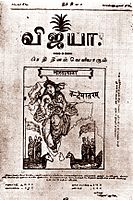THE CHANDRAYAAN -3
Chandrayaan-3 (transl. "mooncraft";[6][7] pronunciation (help·info)) is the third lunar exploration mission by the Indian Space Research Organisation (ISRO).[8] It consists of a lander and the Pragyan rover similar to Chandrayaan-2, but does not have an orbiter. Its propulsion module behaves like a communication relay satellite. The propulsion module carries the lander and rover configuration until the spacecraft is in a 100 km lunar orbit.[9][10]Chandrayaan-3
Chandrayaan-3 Integrated Module
Mission type
Lunar lander, rover, Propulsion Module
Operator
Indian Space Research Organisation (ISRO)
Website
www.isro.gov.in/Chandrayaan3_New.html
Mission duration
Vikram lander: ≤ 14 days (planned)
Pragyan rover: ≤ 14 days (planned)(equal to one lunar day as the equipment works on solar energy)
Spacecraft properties
Bus
Chandrayaan
Manufacturer
Indian Space Research Organisation (ISRO)
Launch mass
3900 kg
Payload mass
Propulsion Module: 2148 kg
Lander Module (Vikram): 1752 kg including Rover (Pragyan) of 26 kg
Total: 3900 kg
Power
Propulsion Module: 758 W Lander Module: 738W, WS with Bias Rover: 50W
Start of mission
Launch date
14 July 2023 14:35 IST, (9:05 UTC)[1][2]
Rocket
LVM3 M4
Launch site
Satish Dhawan Space Centre
Contractor
Indian Space Research Organisation (ISRO)
Moon lander
Spacecraft component
Rover
Landing date
23 August 2023 17:47 IST, (12:17 UTC)[3][4]
Landing site
69.367621 S, 32.348126 E[5]
Chandrayaan programme
← Chandrayaan-2Lunar Polar Exploration Mission →
Following Chandrayaan-2, where a last-minute glitch in the landing guidance software led to the lander crashing after entering lunar orbit, another lunar mission was proposed.[11]
The launch of Chandrayaan-3 took place at 14 July 2023, at 2:35 pm IST[12] and injection of 100 km circular polar orbit was completed successfully as part of phase one.[2][13]The lander and rover is expected to land near the lunar south pole region on 23 August 2023.
चंद्रयान-3 चांद पर खोजबीन करने के लिए भारतीय अंतरिक्ष अनुसंधान संगठन (इसरो) द्वारा तैयार किया गया तीसरा चंद्र मिशन है। [2] इसमें चंद्रयान-2 के समान एक लैंडर और एक रोवर होगा, लेकिन इसमें ऑर्बिटर नहीं होगा।[3] [4]
चंद्रयान-3
चन्द्रयान-3 का एकीकृत मॉड्यूल
चन्द्रयान-3 का एकीकृत मॉड्यूल
मिशन प्रकार
चन्द्र लैंडर तथा रोवर
संचालक (ऑपरेटर)
भारतीय अंतरिक्ष अनुसंधान संगठन (इसरो)
वेबसाइट
चंद्रयान 3
मिशन अवधि
विक्रम लैंडर: <15 दिन
प्रज्ञान रोवर: <15 दिन
अंतरिक्ष यान के गुण
बस
चंद्रयान
निर्माता
भारतीय अंतरिक्ष अनुसंधान संगठन(इसरो)
पेलोड वजन
प्रोपल्शन मॉड्यूल: 2148 किग्रा
लैंडर मॉड्यूल (विक्रम): 26 किग्रा के (प्रज्ञान) रोवर सहित 1752 किग्रा
कुल: 3900 किलोग्राम
ऊर्जा
प्रोपल्शन मॉड्यूल: 758 W
लैंडर मॉड्यूल: 738 W
रोवर: 50 W
मिशन का आरंभ
प्रक्षेपण तिथि
14 जुलाई 2023 14:35 IST, (9:05 UTC)[1]
रॉकेट
LVM3 M4
प्रक्षेपण स्थल
सतीश धवन अंतरिक्ष केंद्र
ठेकेदार
भारतीय अंतरिक्ष अनुसंधान संगठन
----
भारतीय चन्द्रयान अभियान(इसरो)
← चंद्रयान-2 चंद्र ध्रुवीय अन्वेषण मिशन (LUPEX) →
ये मिशन चंद्रयान-2 की अगली कड़ी है, क्योंकि पिछला मिशन सफलता पूर्वक चांद की कक्षा में प्रवेश करने के बाद अंतिम समय में मार्गदर्शन सॉफ्टवेयर में गड़बड़ी के कारण सॉफ्ट लैंडिंग के प्रयास में विफल हो गया था, सॉफ्ट लैन्डिंग का पुनः सफल प्रयास करने हेतु इस नए चंद्र मिशन को प्रस्तावित किया गया था। [5]
चंद्रयान-3 का लॉन्च सतीश धवन अंतरिक्ष केंद्र शार, श्रीहरिकोटा से 14 जुलाई, 2023 शुक्रवार को भारतीय समय अनुसार दोपहर 2:35 बजे निर्धारित किया गया है।[6]









